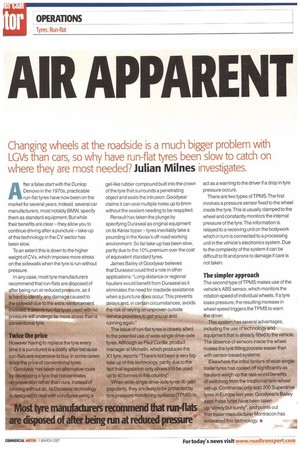R APPARENT
Page 60

If you've noticed an error in this article please click here to report it so we can fix it.
Changing wheels at the roadside is a much bigger problem with LGVs than cars, so why have run-flat tyres been slow to catch on where they are most needed? Julian Milnes investigates.
After a false start with the Dunlop Denovo in the 1970s, practicable run-flat tyres have now been on the market for several years. Indeed, several car manufacturers, most notably BMW, specify them as standard equipment. But while their benefits are clear—they allow you to continue driving after a puncture —take-up of this technology in the CV sector has been slow.
To an extent this is down to the higher weight of CVs, which imposes more stress on the sidewalls when the tyre is run without pressure.
In any case, most tyre manufacturers recommend that run-flats are disposed of after being run at reduced pressure, as it is hard to identify any damage caused to the sidewall due to the extra reinforcement involved. It seems run-flat tyres used with no pressure will undergo far more stress than a conventional tyre.
Twice the price
However having to replace the tyre every time it is punctured is a costly affair because run-flats are expensive to buy, in some cases twice the price of conventional tyres.
Goodyear has taken an alternative route by developing a tyre that concentrates on prevention rather than cure. Instead of running without air, its Duraseal technology is designed to deal with punctures using a gel-like rubber compound built into the crown of the tyre that surrounds a penetrating object and seals the intrusion. Goodyear claims it can seal multiple holes up to 6mm without the sealant needing to be reapplied.
Renault has taken the plunge by specifying Duraseal as original equipment on its Kerax tipper—tyres inevitably take a pounding in the Kerax's off-road working environment. So far take-up has been slow, partly due to the 10% premium over the cost of equivalent standard tyres.
James Bailey of Goodyear believes that Duraseal could find a role in other applications: "Long-distance or regional hauliers would benefit from Duraseal as it eliminates the need for roadside assistance when a puncture does occur. This prevents delays and, in certain circumstances, avoids the risk of relying on unproven outside service providers to get you up and running again."
The issue of run-flat tyres is closely allied to the potential use of wide-single drive-axle tyres. Although as Paul Cordle, product manager at Michelin, which produces the X1 tyre, reports: "There's not been a very big take up of this technology, partly due to the fact that legislation only allows it to be used up to 40 tonnes in this country" When wide-single drive-axle tyres do gain popularity, they are likely to be protected by tyre pressure monitoring systems (TPMS) to act as a warning to the driver if a drop in tyre pressure occurs.
There are two types of TPMS.The first involves a pressure sensor fixed to the wheel inside the tyre.This is usually clamped to the wheel and constantly monitors the internal pressure of the tyre. The information is relayed to a receiving unit on the bodywork which in turn is connected to a processing unit in the vehicle's electronics system. Due to the complexity of the system it can be difficult to fit and prone to damage if care is not taken.
The simpler approach
The second type of TPMS makes use of the vehicle's ABS sensor, which monitors the rotation speed of individual wheels. If a tyre loses pressure, the resulting increase in wheel speed triggers the TPMS to warn the driver.
This system has several advantages, including the use of technology and equipment that is already fitted to the vehicle. The absence of sensors inside the wheel makes the tyre fitting process easier than with sensor-based systems.
Elsewhere the initial fanfare of wide-single trailer tyres has cooled off significantly as hauliers weigh up the real-world benefits of switching from the traditional twin-wheel set-up. Continental only sold 200 Superdrive tyres in Europe last year. Goodyear's Bailey says these tyres have been taken up slowly but surely", and points out that trailer manufacturer Montracon has embraced this technology. •


























































































































































































